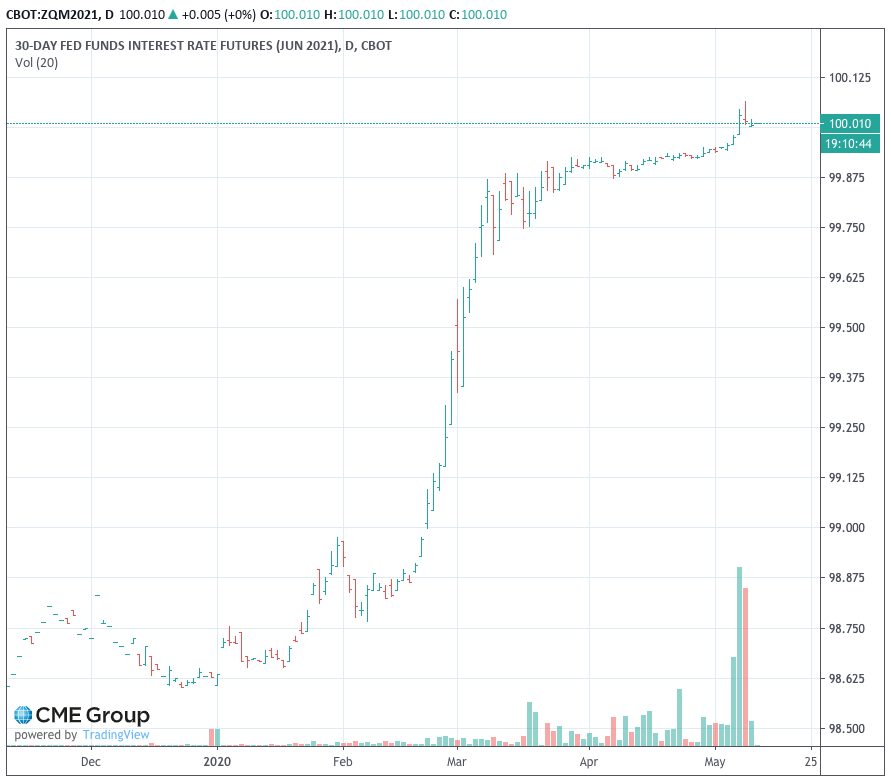The United States Federal Funds interest rate futures contract continues to digest the interest rate environment that may be negative in the future.
On the evening of May 11, Beijing time, the Fed ’s Federal Fund Interest Rate Futures began to set a small price for negative interest rates that occurred in June 2021.
The federal funds rate is the overnight lending rate between US banks and the most important monetary policy tool of the Federal Reserve. The Fed calculates and publishes the effective fed fund rate (EFFR) every trading day. This indicator is the weighted average overnight lending rate for the day. As a policy measure, the Fed will maintain this interest rate within the target range Inside. The underlying assets of fed fund futures (hereinafter referred to as FF futures) are 30-day federal fund deposits. The corresponding relationship between the quotation and the delivery month EFFR is: FF futures quotation = 100-arithmetic average of the delivery month EFFR.
 < / div>
< / div>
 < / div>
< / div>
According to the US CME Group, the closing price of the June 2021 FF futures contract was 100.010 on the evening of May 11, which means that the market believes that June EFFR The arithmetic mean is -0.01%.
 < / div>
< / div>
 < / div>
< / div>According to the US CME Group, the closing price of the June 2021 FF futures contract was 100.010 on the evening of May 11, which means that the market believes that June EFFR The arithmetic mean is -0.01%.
On May 7, the contract price of the US federal funds futures in January 2021 rose above 100.00, which means that traders in the federal funds futures market expect that The Fed may be forced to lower the policy rate, the federal funds rate, to a negative value in January next year.
Zhang Jiqiang, chief fixed income analyst of Huatai Securities, believes that the price of certain period of federal funds futures rose above $ 100, implying the opening of the “zero lower limit” for the federal funds rate for the corresponding month Mainly due to technical factors: the effective federal funds rate since April is out of target rangeThe lower limit is relatively close, and some market participants expect it to rise slightly with the Fed ’s excess reserve interest rate (IOER), which looks both “legitimate” and has good odds. However, the Fed did not raise the IOER on April 30, passing a firm and loose policy stance, triggering this short covering and causing the jump in federal funds futures prices. However, if the perspective is lengthened and the short covering is behind, it is precisely that the Fed may maintain a looser policy for a longer period of time. Whether the short-term interest rate of the United States and even the yield of the US debt will turn negative still deserves close attention.
One game point for investors to bet on the effective federal funds rate recovery is the April 30 FOMC meeting: if the Fed raises IOER, it will bring a corresponding recovery in EFFR . But the Fed not only did not adjust the policy interest rate that day, and then Fed Chairman Powell and several Fed officials expressed their stance that they would maintain loose policies for a longer period of time. The team of Zhang Jiqiang believes that the short-term game point failure brings short covering, which is a possible explanation for the “price in negative interest rate” of FF futures.
Several Fed officials expressed their opposition to negative interest rates. Atlanta Fed Bostic also said on May 11 that he is not keen on negative interest rates. He pointed out that negative interest rates are one of the weaker tools in the Fed ’s toolkit and should not be supported within the Fed in the short term.
Are traders overreacting?
Huatai Securities Research Institute believes that some US federal funds futures rose above 100, which is why the market believes that the Fed may maintain a looser policy for a longer period of time, and US short-term interest rates and even U.S. debt yields Turning rates negative is not impossible.
Zhang Jiqiang ’s team pointed out that the United States has continued fiscal expansion since the 2008 crisis, at the cost of a net increase in U.S. debt issuance, and the average remaining maturity of stock U.S. debt is also in history At a longer level, the U.S. Treasury stock and the average remaining maturity continue to hit new highs is a high probability event. The arrival of a large number of long-term supplies poses no small challenges to market demand. The pressure of unbalanced supply and demand may force the Fed to maintain loose monetary policy. From this perspective, market price in “negative interest rates” is also justifiable.